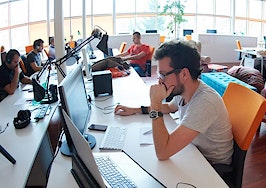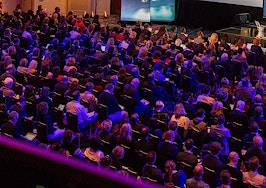“I want to go to 2026,” said Chad Curry at Inman Connect New York, who said that in 10 years, we will have clothes that can tell how comfortable we are, and they will regulate our home to help make us more comfortable. Our beds will know what time we wake up, and our homes might expand our rooms when we have company.
Curry covered five different areas of technology progression that real estate agents should be paying attention to so they can better advise their buyers and sellers. He discussed a project in Chicago that’s received a grant to put 500 devices around the city to monitor internal comfort levels — light, noise, carbon dioxide, carbon monoxide. It’s called the “Array of Things” project, and it’s designed to teach us more about how we live and move in the world around us.
See the other four tech developments to watch out for in the video.
Please see the entire transcript of Chad’s talk below:
So I want to talk to you about five mind-blowing technologies of the future and I’ve got only ten minutes to do it so please grab the helmet underneath your chair to keep the mind matter from splattering on your neighbor next to you. Just kidding.
I want to go to 2026. And in the year 2026 you’re going to have clothes that know how comfortable you are. And they’ll regulate your home based on your comfort level. You’ll lay in a bed that knows when you get up in the morning so it can start your day. You’ll install new windows and as soon as you install those new windows in your home they’ll update the listing with information about those windows and what they mean for your listing. Your energy will come from a micro grid on your street manufactured from wind and solar and it’ll be stored in a battery that looks like a light. You’ll have a house that when you have company come in a simple gesture will turn your desk into a bed and expand the room by 10 to 15 feet, the dining room, so you can have more people attending a dinner.
So what I’m going to do now is walk you through five different areas that I just covered in that short little visit to the future. I’ll talk about what’s currently on market and what’s happening now and how that will move into that space.
So one of the first things I want to talk about is a project that’s happening in the city of Chicago. Now we’re working at CRT on internal comfort levels. So things like carbon dioxide, carbon monoxide, temperature, humidity, light and noise, and how you can help homeowners have a better quality of life by looking at those metrics. That’s what the Array of Things project is doing for the city of Chicago and they just received a $3.1 million grant to put 500 of these devices all up over the city. And having these devices up in the city it’s going to allow us to understand how we’re living in that city. So you’ll know how many people are moving through a city but you won’t necessarily know who that person is. You’ll see that there’s people moving but you don’t know who they are. You just know that there’s a number of people in a specific area. Now for us that data is open and we’re very excited about that because that means we could have tools that could help us be proactive and improving quality of life for the citizens in that city and help raise property values.
Now the thing about this project is there are about 60 different sensors and they have about 15 cities that have currently signed up to be a part of it.
The second thing I want to talk to you about are smart cars, self-driving cars. Right? These will also have sensors in them. You have a listing appointment at 4 o’clock. No worries. Your child has soccer practice. You can’t take them there. But you’ll know the entire journey when your car goes to pick them up from school until they get to soccer practice. You’ll know exactly where they’re at and who they’re with that entire time. Right? Now this is a safety issue but it’s also about you’re making sure you’re maximizing your time. And there are three there. There’s one from Tesla. And actually anybody seen the software update recently released from Tesla? The new self-driving on highways? It’s actually a real thing now. Right? It’s actually happening. We’re in the future. Enjoy it. The funny one with the little fez hat there. If you could put the picture back up. The fez hat car is actually by Google. And the one that looks extremely futuristic is from Mercedes-Benz. Very interesting stuff. Think about what you could accomplish while you’re being driven around, an entire family is being driven around.
So the sensors I talked about, being able to detect. This is a project from University of Michigan called M Cube, the Michigan Micro Mote. This is the size of a grain of sand. Imagine if you could have the type of data about a room that could help a family improve quality of life in that room that was granular. Imagine if this were in drywall or a bucket of paint and you could get a sense of the temperature and the humidity and the lights and all of those metrics. And help them improve on particular matter levels, help them improve on airflow, help them stop a mold problem before it starts.
So those are the internet of things devices. And now I want to talk to you about how we’re going to interact with these things and it’s called Zero UI, which stands for Zero User Interface. Currently when you work with an application on a computer you have this beautiful you know you can almost lick it. Right? The Mac? They say you can lick it. This beautiful screen where you click and do all of that stuff. Right? We’re not going to have that when we interact with our lives, our daily lives.
In fact one of the ways we’ll interact with things are through wearables. So Google has a project called Project Jacquard and there’s another project by a group called Adafruit called Flora that are wearables that help with you interacting with your environment. So imagine if you will I have a couch and I’m sitting on my couch and my spouse is sitting next to me. And the couch knows who is sitting where based on our, our volume. Right? I’ll say my mass. And so what it does, it knows I like light at about a medium level and my wife likes light at a higher level. So it adjusts the lights accordingly to give us both comfort but also keeps us cool and adjusts the volume on the TV in a way that we’re both, we’re both interested in.
You could also use this for things like somebody knocks at the door. You can knock on the door of your couch to throw a video up on the screen, the TV, to see who’s at the door and then slide your finger up to talk to them and knock again to let them in if you want to let them in. So that’s called Project Jacquard. We’re actually very excited about that one.
This is showing it in action. That’s actually a piece of cloth and he’s touching it and the way he’s putting on the cloth, you’ll see the wave forms vary based on pressure. Right? So very interesting stuff there. So that’s one interface. It’s touch. Right? The second interface is gesture.
This is a picture of a car from BMW. Dave Conroy who’s in the room here somewhere he’s a lab engineer for me and he went to CES. We sent him to CES. And out there he rode in a new BMW 7 Series and he was in the back seat and his driver Inga she asked him where he was going and he said, “I’m going to the Golden Nugget.” And she took a finger and on the consul put G-O-L just on the cloth. And up pops Golden Nugget on her screen. She touched, she did this with a gesture and it selected that one. And as she’s driving she’s able to pull up weather or turn the volume up on a song or go to the next song, all through gesture, without having to look at a phone or anything like that. So imagine what that means for a home. And I’ll talk about that one in a second.
The third is voice, natural language processing. We are all equally you know excited and frustrated by Siri and Cortana. Amazon Echo owners, any Amazon Echo owners in the audience? Yeah. Yeah I love the Amazon Echo. It’s a lot of fun. We actually have one in the lab that we programmed to modify lights and what have you. What’s cool about Josh.ai is it’s an open platform where we can build devices with voice integration into them. And you can do things like what they call daisy-chaining. So I could actually say as I walk into a room, “Josh please put the lights at 50% and adjust the temperature to 68o and turn on newts” and that’ll all happen in one fell stroke. Now Josh is actually a really interesting program in that it’s open source which means anybody can work with it. So I’m very excited about that one.
Okay so remember I talked about those windows you installed and they updated your listing, right, they updated information about the home. Who here works in a commercial real estate space? A couple people. Building information modeling is actually for larger commercial buildings right now but I think it’s going to make its way into our area. What I mean by this is as we have these smarter devices what they’re going to do is auto update about what’s in the home. So for instance if I had drywall with these sensors in it it would actually tell me, tell, put on the listing if those sensors were in the home and what types of things they could sense. So it saves you the work of having to adjust that listing. It auto pops that listing. It makes your work easier in that regard. Right? Rather than having to capture all the amenities it can just be auto popped.
Another way I see this happening is through machine learning. There’s a program called Neural Talk and if you take a computer with a camera and you move it around it will try to identify what it sees in front of it. And actually there’s a really interesting video called Neural Talk and Walk. And there’s a part where there’s this guy eating a hotdog and as soon as the Neural Talk finds him eating a hotdog and identifies him you see this look of surprise go over the guys face because he sees himself on the screen and realizes it actually knows what he’s doing. So we’re not too far from walking around if we’re you know in a prelisting, taking video of the place that you’re going to list and being able to have it identify how many bedrooms and baths, the size, square feet, all in one fell stroke as you take this video and go like this.
Alright so renewables. So this is a big area and we think in the next couple of years it’s going to make some huge strides. Right? And there’s a couple of things that are currently in the market that are very, very interesting. Where are the solar panels on this house? You see the solar panels? They’re on the garage. Right? Yeah. So they’re built in. Dow Chemical makes these solar shingles. Right? And they’re priced a little bit high right now but their price is coming down, as more and more are made. So that’s one of the things that’s on the market right now.
This is also something on the market by a company called Rawlemon. This one’s got me really excited because it goes for about $10,000 and it looks a bit like a piece of art. Now here’s the thing. If this isn’t your cup of tea they have some other ones as well. But what’s cool about this is that globe actually concentrates the solar energy onto the photovoltaics. And you see that little stripe in the back, it almost looks like a globe. That stripe in the back there that’s actually the photovoltaics. So it doesn’t take up a lot of space. In can sit on the roof. You can have it in the backyard where it can get a lot of sun. It will harvest that energy. Or a boulevard. Right? Your street on a micro grid. You’re all paying in to share energy from the energy that you’re harvesting. Right? So rather than paying utility you have a neighborhood association where you pay a monthly fee. And there’s a great marketing opportunity for realtors there. Right? On a monthly basis you could go in, instead of adopt a highway you would adopt a street and pay for their energy on a monthly basis on brokerage.
Alright so this is actually one that I’m really excited about. Michigan State University has built solar glass. That is actually a solar panel. So imagine if the windows I just installed were updated on my building information modeling system had this in it. I would have solar panels already built into my home.
This is a tree. Imagine these on a boulevard. These trees with these leaves that spin. Vertical axis wind turbines. So an array of these with leaves that spin. They look more like art than they actually do those giant ones that are spinning constantly in Iowa where I’m from. Right?
This is one that’s on the market and they just started a Kickstarter yesterday and got funded today. Orison Energy. Alright? Orison Energy. Orison.energy is their website. Alright? We’ve been talking to them. We’re very excited about this one and I’ll tell you why. This, the tower goes for about $2,000. The picture frame looking one goes for about $1,500. And they are batteries. They’re home batteries. After you’re collecting all this energy with those devices I just talked about you’ve got a place to store it. Not only is the tower a battery it’s also a light, it’s also an inductive charger, it’s also a USB charger, and it also tells you what your energy usage is in the home. The way you install it is you plug it into the wall. You plug it into the wall. Your solar panels are creating energy. The extra energy from your solar panel goes right into the Orison. The Orison stores that energy when it realizes that the solar panels no longer being excitated by the sun it will push the energy out throughout the house and push it where it’s needed based on its monitoring of the home. They have a ten year warranty. They will send you a replacement battery when it’s needed because they’re monitoring battery usage on them.
Finally I want to talk about responsive architecture. And there’s one company in particular I want to talk about and they’re called AcreDesigns Axiom House. AcreDesigns was just, they’re part of Y Combinator. Anybody familiar with Y Combinator? Yeah they do a lot of tech startups. Right? They’ve put money into this house. This house is a prefab ecofriendly sustainable home that will cost between 250 and 500K. They have various models and you can add things to it to make the cost vary.
What I want to show you is the inside. And what’s cool about this, what they’re building it to be is responsive. So as you need more space they want you to be able to add that space. So let’s say you have a room that’s walled off. You can remove those walls very easily and have a larger space if you need it. Or if you want to have a smaller space you can wall off a room very simply to what they’re building. These are net zero and they’re all environmentally friendly.
And I talked about gestures, changing your desk space into a bed. Right? This company called MorphLab. They’re part of MIT and they’ve got this company now where for micro units they have this gesture based program to help you rearrange your space. We’re very excited about what they’re doing. We’re seeing how we can test it in our laboratories. We think this is going to be the way of the future because you know you want to modify how you’re living. Right?
So that’s it for me. I only had ten minutes. I hope you enjoy the future over the next ten years. Please reach out to me. I am very serious about that. I like hearing from members. We’re looking for field lab testers for us for what we’re doing with smart home technologies and other technologies. So please reach out to me. Ccurry, can you put my information up just so they can take a picture of that if they want to? Or just Tweet it with my address. We’ve got ccurry@realtors.org or chad@crtlabs. I want to thank you very much. Thanks.









